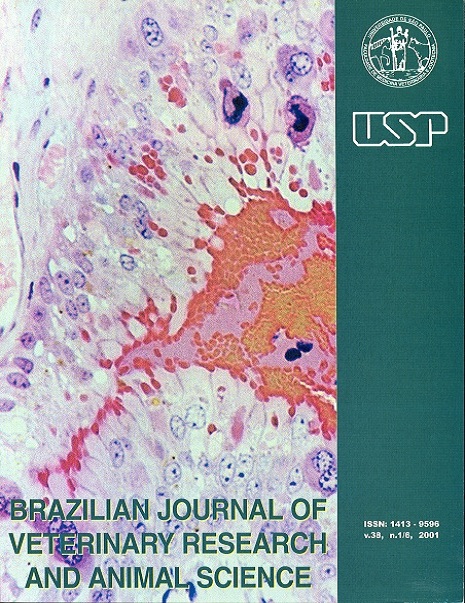Are there relationships between the luteal size, luteal morphoechogenicity by ultrasound and plasmatical progesterone concentrations in recipient mares?
DOI:
https://doi.org/10.1590/S1413-95962001000500007Keywords:
Equine, Corpus luteum, Progesterone, MorphoechogenicityAbstract
Corpus luteum (CL) synthesizes progesterone (P4), which has a major function in maintenance of pregnancy in equine females and also enables the application of biotechnologies of reproduction. Considering the importance of the CL and its anatomical and physiological features to achieve normal pregnancy, our aims were to determine the size and morphoechogenicity (ME), as well as plasma P4 concentrations of corpus luteum from recipient mares for nine days after ovulation (D0). Therefore, 57 recipient mares were examined daily by transrectal ultrasonography (US) from early signals of estrus to D9. CLs were measured and their ME classified according to a 1 to 6 scale (1=anechogenic; 6=hiperechogenic). Blood samples were collected daily and progesterone concentrations assessed by radioimmunoassay. Pregnancies were checked by US 13 and 25 days after ovulation. Corpus luteum echogenicity had a tendency to increase from D0 to D9. Progesterone concentrations were < 2,16 ng/ml until D3, but there was a significant elevation from D4 to D9 (3,41 to 4,33 ng/ml). There were no differences in CL size, except between D2 (31,54 mm) and D8 (25,95 mm); p < 0,05). Thus, an increase in mean luteal ME is accompanied by an increase in plasmatic P4 concentration, but this event seems independent of luteal size. There were no differences between ME, size and P4 levels from D0 to D9 in recipient mares that became pregnant or not after embryo transfer.Downloads
Download data is not yet available.
Downloads
Published
2001-01-01
Issue
Section
VETERINARY MEDICINE
License
The journal content is authorized under the Creative Commons BY-NC-SA license (summary of the license: https://
How to Cite
1.
Arruda RP de, Visintin JA, Fleury JJ, Garcia AR, Madureira EH, Celeghini ECC, et al. Are there relationships between the luteal size, luteal morphoechogenicity by ultrasound and plasmatical progesterone concentrations in recipient mares?. Braz. J. Vet. Res. Anim. Sci. [Internet]. 2001 Jan. 1 [cited 2026 Jan. 13];38(5):233-9. Available from: https://revistas.usp.br/bjvras/article/view/5877





